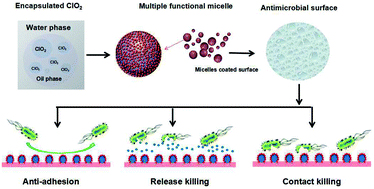A smart multi-functional coating based on anti-pathogen micelles tethered with copper nanoparticles via a biosynthesis method using l-vitamin C
Abstract
A multi-functional anti-pathogen coating with “release-killing”, “contact-killing” and “anti-adhesion” properties was prepared from biocompatible polymer encapsulated chlorine dioxide (ClO2) which protected the active ingredient from the outside environment. A slow sustained-release of ClO2 from micelles over fifteen days was detected for long-term release-killing. Micelles only release ClO2 on demand in minimum inhibitory concentrations. We prepared nanoparticles which were covalently clustered on micelle surfaces to improve contact-killing as well as to improve the stability of the micelle. Copper nanoparticles were generated using the biosynthesis method including L-vitamin C, which avoids the toxicity and allows for the preparation of copper nanoparticles in a green environment. Synergistic anti-pathogen activity could be generated by a combination of micelle released ClO2 and ascorbic acid. In addition to release-killing and contact-killing, a pluronic polymer coated surface also provides an additional “anti-adhesion” property through its protein-repelling ability. In this research, the designed coating demonstrated a broad-spectrum of activity to kill drug-resistant bacteria, viruses and spores in short period of time. Based on scanning electron microscopy (SEM), transmission electron microscopy (TEM) and anti-oxidase assays, we found that the designed coatings killed the pathogens via bio-oxidation. We also carried out acute respiratory toxicity tests in this research. Analysis of blood samples, lung function and histopathological slices indicated that the synthesized micelles allowed a controlled and sustained release of ClO2 to kill pathogens while maintaining an overall ClO2 concentration in the air within a safe range.



 Please wait while we load your content...
Please wait while we load your content...